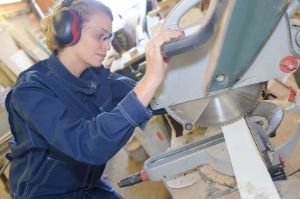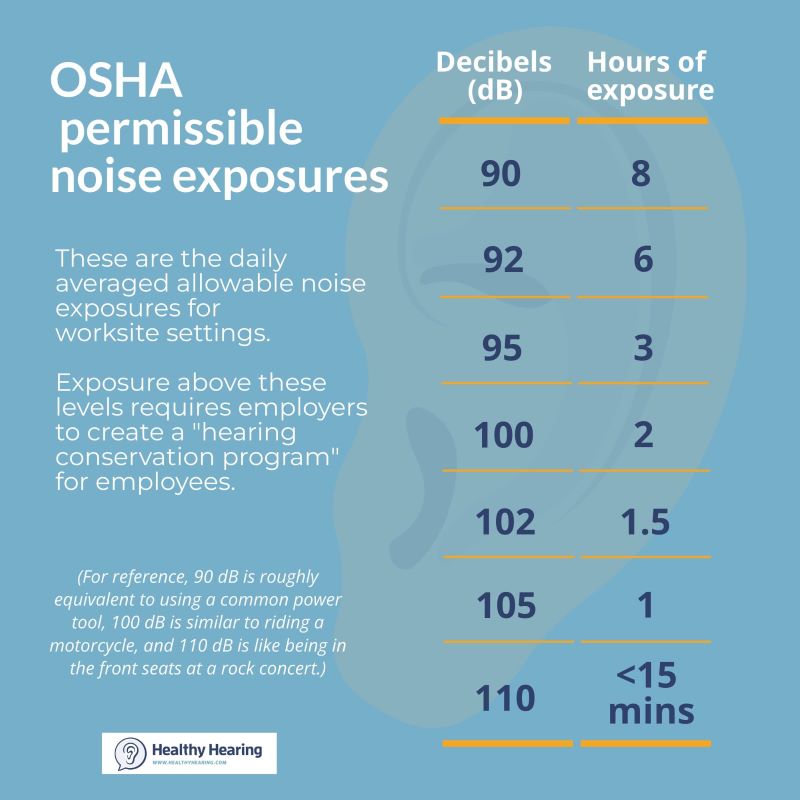|
www.HealthyHearing.com |
OSHA worksite noise regulationsFind out what the laws are for loud noise exposure at work
Contributed by Joy Victory, managing editor, Healthy Hearing Worried about noise exposure on the job? You're not alone. Work is one of the most common places you can be exposed to harmful levels of noise, which puts you at risk of noise-induced hearing loss (NIHL). As many as 22 million US workers are considered at risk to hazardous noise levels, according to the CDC. Fortunately, the US Occupational Safety and Hazard Administration (OSHA) has standards and programs aimed at reducing the risk of hearing loss among American workers. Let's take a look: OSHA hearing conservation program
According to OSHA's standards, employers must implement a hearing conservation program "when noise exposure is at or above 85 decibels averaged over 8 working hours, or an 8-hour time-weighted average (TWA)." This does not mean you have to be exposed to eight continuous hours of loud sound to qualify for help with noise exposure. The key phrase is "averaged." This means if you have just two hours of very loud sound exposure (100 dB or above) in an otherwise quiet workplace, you've still met that 8-hour average threshold. You can see how this plays out on the chart above. Or visit OSHA's chart for permissible noise exposures. How do hearing conservation programs work?In general, OSHA's hearing conservation programs "strive to prevent initial occupational hearing loss, preserve and protect remaining hearing, and equip workers with the knowledge and hearing protection devices necessary to safeguard themselves." What does this look like in real life? Essentially, that employers develop and carry out plans that reduce noise in the work environment while also providing equipment and materials that help workers protect themselves. For example, a laborer may be given lower-noise power tools and earmuffs that lower sound levels to less harmful levels, and receive education on NIHL. Other parts of a hearing conservation program include:
Additionally, OSHA has developed a specific set of hearing standards for the construction industry. How to reduce noise in the workplaceA good noise reduction plan should include measurement of sound levels in the workplace followed by making changes that actually reduce noise levels—and not just handing out earplugs to a few workers and hoping they'll use them appropriately. Engineering controls
take steps to protect their workers from harm, including hearing loss. Reducing noise can be done in many ways, which OSHA calls "noise controls." When an employer makes changes to equipment or the surrounding environment, it's known as an "engineering control," such as putting up a barrier or curtain that blocks sound, and/or purchasing low-noise tools and machines. Administrative controlsAnother way to reduce noise is to use administrative controls. This means employers makes adjustments to the work schedule or workplace that don't require much physical modification. For example, limiting a worker's amount of time spent at a noisy machine, or running noisy equipment when fewer workers are around, or even providing a "quiet area" where workers can rest their ears. If you are a small business looking to find ways to reduce harmful noise or other workplace hazards, you may qualify for OSHA's on-site consultation program to improve the safety of your employees. What about earmuffs, earplugs or noise-canceling headphones?Earplugs and earmuffs can certainly help, but as OSHA explains, hearing protection devices "are considered an acceptable but less desirable option to control exposures to noise." They are often used when:
In other words, they put a Band-aid on the problem, but do not cure it. Noise-canceling headphones are great for blocking out ambient noise when you're listening to music or a podcast. However, they can't protect against sudden, explosive sounds and aren't meant to be used as hearing protection in the workplace. Regardless, it is always a good idea to protect your hearing from harmful noise, whether at work and at home. Healthy Hearing recommends everyone own earplugs or earmuffs and wear them when doing noisy things, such as firing guns or listening to live music, regardless of age or background. How do you know if a sound is too loud?You might be wondering how loud is too loud? A quick rule of thumb is if you need to raise your voice to speak to someone three feet away, then it may be too noisy (over 85 dB). You can also use sound measurement apps, including one from OSHA, to directly measure sound in your environment. Unfortunately, not all worksite sound is predictable or easily measurable. harmful. Sudden blasts at a worksite, for example, may only last seconds but cause severe hearing damage. Or you may not have thought your environment was loud initially, but after awhile you begin to experience symptoms like muffled hearing or ringing in the ears. Even if these symptoms go away, they are signs that you were exposed to harmful sound levels. More: Decibel levels of common sounds What are workers' rights for hearing safety?Workers have the right to a safe workplace and freedom from being affected by noises loud enough to induce hearing loss. In regards to their hearing, the Occupational and Safety Act (OSH) of 1970 provides workers with the rights to:
Workers' comp for hearing lossIn many situations, workers can file for workers' compensation benefits if they believe their hearing has been damaged on the job. This varies widely by state. What if my employer isn't helping with noise levels?It's important to know you have resources if your employer is not doing enough to protect workers' hearing. OSHA provides a wealth information for workers on their site. They also provide specific guidance on what to do if you're being exposed to any harmful activities, not just noise. If you feel your workplace has become unsafe, you may file a complaint with OSHA at any time. Seek treatment for noise-induced hearing lossIf you've noticed changes to your hearing or are experiencing tinnitus following exposure to loud noise, it's important to get evaluated by a hearing specialist in your area. Early treatment for hearing loss and other related conditions improves your quality of life and can help you take steps to prevent further damage from occurring. Joy Victory, managing editor, Healthy Hearing
|
Featured clinics near me
Earzlink Hearing Care - Reynoldsburg
7668 Slate Ridge Blvd
Reynoldsburg, OH 43068

Find a clinic
We have more hearing clinic reviews than any other site!



 Joy Victory has extensive experience editing consumer health information. Her training in particular has focused on how to best communicate evidence-based medical guidelines and clinical trial results to the public. She strives to make health content accurate, accessible and engaging to the public.
Joy Victory has extensive experience editing consumer health information. Her training in particular has focused on how to best communicate evidence-based medical guidelines and clinical trial results to the public. She strives to make health content accurate, accessible and engaging to the public.